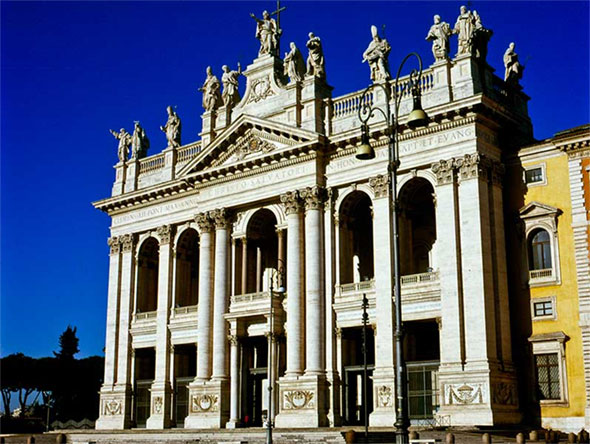9 November 2014
Homily of the Apostolic Nuncio
His Grace Archbishop Petar Rajič
Ez 47:1-2, 8-9, 12; 1 Cor 3:9c-11, 16-17; Jn 2:13-22
There are three feasts in the liturgical year that commemorate the dedication of the four major basilicas in Rome. Today we celebrate the Dedication of the Lateran Papal Arch-basilica, which is the cathedral church of the Diocese of Rome. It was originally built by the Roman emperor Constantine during the times of Pope Sylvester I (314-335) and dedicated to Christ the Savior, in honor of Saint John the Baptist and St John the Evangelist. It is considered the mother of all Churches – of the City of Rome and of the globe. In a few days, on November 18th, the feast of the dedication of the two basilicas of St. Peter’s in the Vatican and St. Paul’s outside the Walls will be celebrated. The fourth major basilica, not least in importance and the largest church in honour of Mary the Mother of God, is the Basilica of Saint Mary Major, and the dedication is commemorated every year on August 5th.
The Lateran basilica was the first church built after the liberation of Christians in 314 and this church was for many centuries the seat of the Bishop of Rome, who is the Pope. Even today it is considered the cathedral of the Pope and the current basilica was completed in the 18th century. On the facade of the basilica, there is a Latin inscription: Sacrosancta Lateranensis ecclesia omnium urbis et orbis ecclesiarum mater et caput, meaning “Most Holy Lateran Church, of all the churches in the city and the world, the mother and head”. In celebrating this feast we are recalling our unity in love with the Holy Father the Pope, who is the Bishop of Rome, Vicar of Christ and Supreme Pontiff of the Universal Church. The Holy Father is the visible leader of the Church on earth, yet Christ the Lord remains forever the Head of the Church he established upon the faith of the Apostle Peter and his successors.
 In commemorating the dedication of the Lateran Basilica we are not celebrating the construction of the church, for the building is only a collection of stone and brick, which can appear cold and lifeless. Yet what takes place inside the basilica and in all the churches throughout the world is something full of life, and this is our worship and prayer, expressed in the Holy Eucharist and other sacred liturgies.
In commemorating the dedication of the Lateran Basilica we are not celebrating the construction of the church, for the building is only a collection of stone and brick, which can appear cold and lifeless. Yet what takes place inside the basilica and in all the churches throughout the world is something full of life, and this is our worship and prayer, expressed in the Holy Eucharist and other sacred liturgies.
The Lord Jesus teaches us in the gospel that the temple is exclusively a place destined for prayer and the worship of God. The anger of Jesus reminds us of the words of the psalmist: Zeal for your house will consume me (Ps 69:9). The first and foremost importance of the temple is its function as a place for communal prayer. It is in this very temple, where men and women can come to know the presence of the living God. All are invited to discover our own inner temple, which is where God prefers to dwell. By examining ourselves, our hearts and minds, and seeking to pray to our heavenly Father from our hearts, we come into direct contact with our Creator and Father. We are therefore living temples of the living God. Our God is with us always, in every activity we do no matter how small it may be. He is constantly with us in order to participate in and enrich our lives with His presence. Let us offer to God then, the true worship He deserves, through our lives and our efforts to adhere to His commandments, listen to His Son Jesus and follow Him with our lives.
Further on in this passage Jesus boldly states: Destroy this temple and in three days I will raise it up. Those who heard him speak were mystified by his words for they were thinking of the huge temple in Jerusalem that took 46 years to complete. Jesus was however referring to his body and his future death and resurrection. Jesus became the victor of death by willingly accepting the destruction of his body, his own temple and then rising from the dead. In this, we see that the work of God is to raise up again, to rebuild and to resurrect.
It is so unfortunate that we humans are very good at destroying things, whether they be friendships, relationships, marriages, nature around us, our own bodies and the very structures that we ourselves build. At the root of all this destruction and evil is human folly and sin. However, as believers in God, who is the Creator and Father of all, we know and believe that despite all the destruction in the world, all of our personal failures and limitations, it is the Lord who lifts us up. It is he who through his merciful forgiveness raises up, rebuilds and resurrects our lives, when we approach him with faith and offer ourselves up to him in humility and sincerity. Here we come to the realization that our contact with God, our entry into his presence, our approach to him is not dependent on anything that men’s hands can build or men’s minds devise. In the street, in the home, at school, at business, on the hills, travelling on the open road or in the air, and while in church, we have our inner temple, the presence of the Risen Christ forever with us throughout the entire world.
Sacred places such as the basilicas of Rome, are therefore special places of prayer where we celebrate our liturgies and offer our prayers to the living God. When we go into a chapel or church, we bring to mind that this place is the house of God and that we are invited to offer to the Lord our worship in spirit and in truth, so that he can find a new and permanent dwelling place in our hearts.


